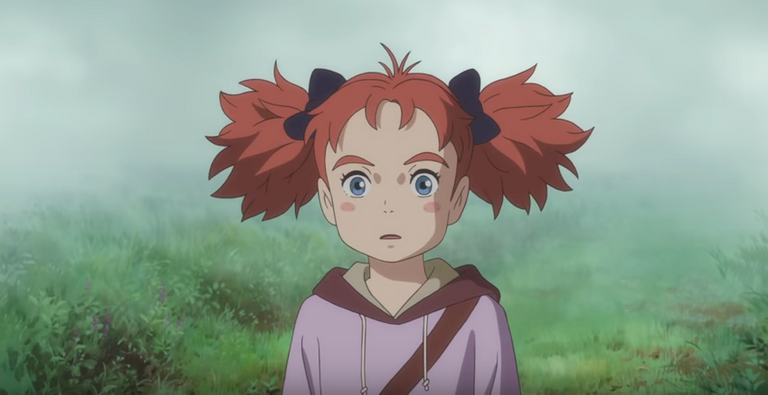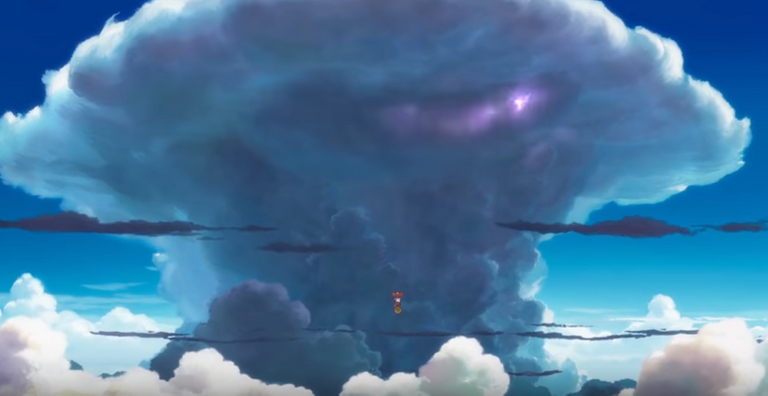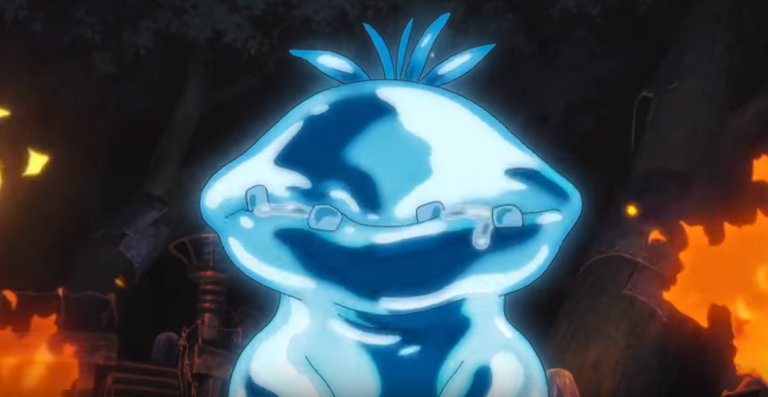Studio Ghibli is functionally gone. At first, I was debating whether I could make this entire video without mentioning the old animation studio. However, when the first thing out of anyone’s mouth upon seeing the poster for this film was something along the lines of, “This looks like a Ghibli clone,” that makes it a topic that would be impossible for me not to broach.
So what do I mean when I say that it’s functionally gone? Well, the studio closed its doors back in 2014 after the release of the film When Marnie Was There, and much of the talent that worked at the legendary studio has since moved on. Now, there is still a film in production at the sort of reopened studio – what with Miyazaki out of retirement again, because that man won’t stop working until he dies – but by and large the Ghibli that we know and love remains in spirit only.
In the physical world that we occupy, however, not all hope is lost. For those animated film fans such as myself, there are many creators and studios to fill in the gaps like Studio Ponoc, and their first animated feature that we will be discussing today. Ladies, gentlemen, and others, my name is Arkada and today on Glass Reflection we’re looking at Mary and the Witch’s Flower. Let’s jam.
Story & Characters
So what is this film really? It looks like Ghibli, it acts like Ghibli, it feels like Ghibli, but is it a rip-off or something entirely different? The similarities are not all that hard to understand when you look at the studio helming the feature. Newly formed Studio Ponoc was created by a former Ghibli producer, which means they have a lot to prove and a name to make for themselves. So how did they fair? Well, safe is a word that I would use, but not necessarily in a bad way.

Mary and the Witch’s Flower is a film based off of a 1971 children’s novel by writer Mary Stewart called The Little Broomstick. It follows the story of a young red-headed English girl named Mary who, through circumstance and luck, comes across a magic flower and an old witch’s broom. After accidently absorbing the magic from the flower and activating the broom, she is whisked away to a nearby magical college where she is thrown into a world of magic and monsters and all things that you would expect from British literature about magic written in the 1970’s.
Or really, just British literature in all honesty, as there are plenty of moments when you could pick out elements from other well-known fantasy novels from that side of the pond. And hell, if someone told me that J. K. Rowling was a fan of the original book when she was younger, I’d believe it. But it is a very safe film and I think that ultimately it was the right move. It doesn’t have the same amount of depth as many a Ghibli film from the past does, but it gives inklings about a greater more fantastical world that the characters live in and it would love to show it to you. But oh, look at the time, we need to wrap this up before the film gets too long, chop chop!
It might just be an issue with adapting the original source material, which I will be honest enough to say that I haven’t read. But I have seen Ghibli adapted works in the past and how quite often the world building gets partially sidelined and left underdeveloped in favour of the more important story.

The titular character of Mary easily fits the role of the plucky audience surrogate. She is curious about the world, but has a temper and sometimes lets it get the better of her. She gets angry at the boy she might fancy, even when he’s largely nice to her. Ultimately though, when the chips are down, she risks a heck of a lot to save the day. But at the same time she is quite the example of a Mary Sue – or perhaps, considering her author’s name, a Mary Stew…art. That said there is a bit of comfortable familiarity about her and her story. Watching this film is quite like re-reading an old favourite book of yours, of which you’ve forgotten the details. You know roughly what’s going to happen and in what order, but there’s still the excitement in re-experiencing the whole thing that makes it enjoyable.
The one thing that I was thankfully relieved with was that while I can pick out a variety of either influences from other “young girl turned witch” stories (or perhaps precursors, considering the story’s origins), I was thankful to see a distinct lack of influence from one such story. Kiki.
I fully expected a film about a young witch from a studio that labels itself as a spiritual successor to Studio Ghibi to have some kind of homage to one of the more famous films. But really, aside from the obvious tropes that come along with having a young witch – like the clothing, the broom, the black cat – there are very few visual references to Ghibli’s former witch work. Although it does have many visual references from other Ghibli films instead, but I’ll get to that in a moment.
Animation & Sound
Normally, I would start off this section by talking about the animation, but because I think it’s been overlooked by virtually everyone I have talked to who has seen this film, I first wanted to bring attention to the film’s soundtrack. Now, whenever someone talks about the greatness of Hayao Miyazaki and his films, you would be doing a disservice to not mention the breathtaking music of master Joe Hisashi. Likewise, anyone who talks about this film and does not mention the music by Takatsugu Muramatsu is doing it wrong.
The music that he composed for this film fills in so many gaps left open by other parts of production. It’s this music that adds that extra little bit of wonder and magic to a film that would have been lacking otherwise. It’s also, thankfully, available out on musical services like Spotify and the like, so even if I can’t convince you to go and watch the film today, at the very least I hope you would check out its soundtrack. Trust me, it’s worth it.
I am very much looking forward to his future work because, if it’s anything like this, then I will be musically satisfied with anime films for years to come. Hell, I’ll go watch Lu over the Wall just for his music alone, though I do have some other reasons to go see that film, mostly because Masaaki Yuasa is a genius. But we’re getting really off-track now, so let’s get back to the Ghibli references.

Considering that the film was produced by many Ghibli alumni, it’s not hard to imagine that they took all that they learned with them and the visual style of the film shows that off. But it’s not only there in how the characters and the world were designed. Many of the magical elements are very reminiscent of similar effects from Howl’s Moving Castle and Ponyo, both of which had Mary’s director Hiromasa Yonebayashi as a key animator.

Those aren’t the only visual references though. Heck, I honestly thought for half a moment as Mary got whisked away for the first time that the broom was taking her to the forgotten city of Laputa surrounded by a massive hurricane. Visually, this film is a massive homage to what has come before, and while I enjoyed the nostalgia of it, it does make me curious about what’s to come.

Oh yeah, and there’s also a blob monster that could either be passed off as a reference to No-Face or maybe even the God Warrior from Nausicaa if you want to dig hard enough. Or maybe I was just really wanting to avoid mentioning Spirited Away since I’m not that big of a fan of that particular film personally. But that’s a story for another day, not today.
Final Verdict
What Mary and the Witch’s Flower shows us is that sometimes one of the best ways to tackle the future is to use a little help from the past, both visually and narratively. While some might look at the similarities between it and the films that made Ghibli famous and decide to call it a rip-off, I’m a bit more understanding. It’s quite possible that had Ghibli not closed its doors, Mary would indeed have been a Ghibli film, even if the production took a few different turns along the way.
To me, it’s a Ghibli rip-off in the same way that The Cat Returns is a Ghibli rip-off. “But the Cat Returns IS actually a Ghibli film,” you might say. To which I would respond, “Exactly.” The Cat Returns – for those who have never seen it – looks like a Ghibli film, acts like a Ghibli film, and nobody cares that Miyazaki had little to do with it because it was released by Ghibli themselves. From a production standpoint, Mary is very, very similar. Ghibli may have gone in a different direction, but a lot of the newer talent have learned from their time there, have not disappeared, and are instead continuing to create magical worlds with which we can entertain ourselves. Is it an amazing film? Not especially. But it is an enjoyable film, and as a starting point, I think that Ponoc is doing just fine. Hell, I’d rather re-watch this than Summer Wars.

As such, I’d like to present Mary and the Witch’s Flower with the recommendation to buy it. It was recently released by a film distribution company over here in North America called GKIDS, who specialize in animation. I’m glad that they did, because while this film was on my radar, it probably would have taken me far longer to have watched this movie otherwise and I would have been missing out. I’m hopeful that GKIDS can fill a particular gap that we’ve had in the western anime industry.
Television anime get subtitled, and even dubbed now, mere weeks after their Japanese airing if not immediately, but anime films on the other hand sometimes take months if not years to come across the ocean. While licensers like Eleven Arts have been taking up the mantle alongside Funimation’s own films division, I am happy that we have more companies stepping into the ring and helping out in this regard. Hopefully, this means that we’ll have more anime films brought to us legally in a much timelier manner, but time will tell.
If you’ve already seen Mary and the Witch’s Flower, well then I’ll start with the obvious alternate anime recommendation of Kiki’s Delivery Service for you to check out. I say obvious mostly because it’s on the short list of my favourite anime films ever and really you should have already seen it before now. If not, then go and do that thing. If you have seen it though, my second recommendation is for Little Witch Academia, another take on a witch’s school that focuses far more on actually being a student at said school, something which Mary was never really given the chance to do. Between those two, you should find something to your liking.
And that’s it from me. Until next time, stay frosty!

Very nice review!
I will follow you :)!
For One Piece Theories and discussions, feel free to follow :)!
Much Love
-Ma D. Theorist
I've been you youtube channel for a while now and I must say is one of my favorite on the anime community over there, but here you're the best my man and I really love this one, I think these guys have really good possibilities to be the successor of Ghibli, I mean they have the potential but maybe it all depends if Miyazaki goes on retirement or off... or on... or off...
Curie Curator
Thanks, I'm glad to know my reviews have been able to have a good impact. And yes, we'll have to wait and see what happens with Miyazaki. Somehow I don't think he'll ever be able to allow himself to fully retire. I'm sure decades from now, his ghost will still be around making more anime films, lol.